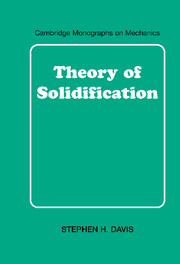9 - Microscale Fluid Flow
Published online by Cambridge University Press: 20 January 2010
Summary
In all the earlier discussions of morphological instabilities, the driver of the morphological changes was the gradient at the front of a diffusive quantity. For the pure material it was an adverse temperature gradient, and for the binary alloy in directional solidification it was an adverse concentration gradient. It seems clear if fluid flow is present in the liquid (melt) that the heat or solute can be convected and hence that its distribution can be altered. Such alterations would necessarily change the conditions for instability. What makes the situation more subtle is that flow over a disturbed (i.e., corrugated) interface will not only alter “vertical” distributions but will also create means of lateral transport, which can stabilize or destabilize the front. The allowance of fluid flow can create new frontal instabilities, flow-induced instabilities, that can preempt the altered morphological instability and dominate the behavior of the front.
It has been known since time immemorial that fluid flow can affect solidification; cases range from the stirring of a partially frozen lake to the agitation of “scotch on the rocks.” Crystal growers are keenly aware of the importance of fluid flows. Rosenberger (1979) states that “non-steady convection is now recognized as being largely responsible for inhomogeneity in solids.”
When one attempts to grow single crystals, the state of pure diffusion rarely exists. Usually, flow is present in the melt; it may be created by direct forcing or it may be due to the presence of convection. Brown (1988) has given a broad survey of the processing configurations and the types of flows that occur.
- Type
- Chapter
- Information
- Theory of Solidification , pp. 274 - 323Publisher: Cambridge University PressPrint publication year: 2001

